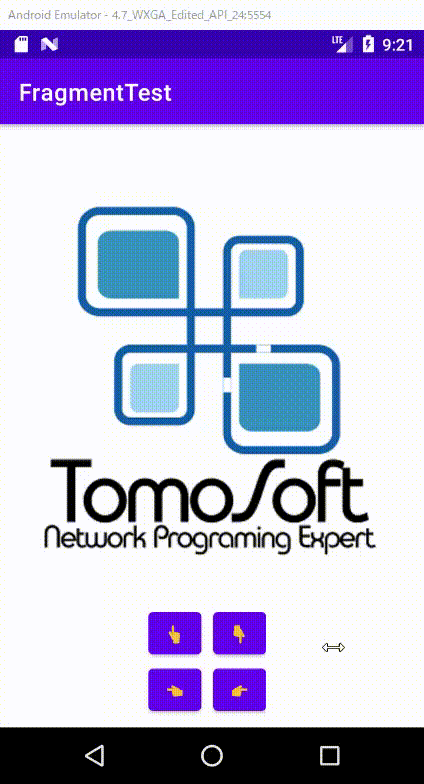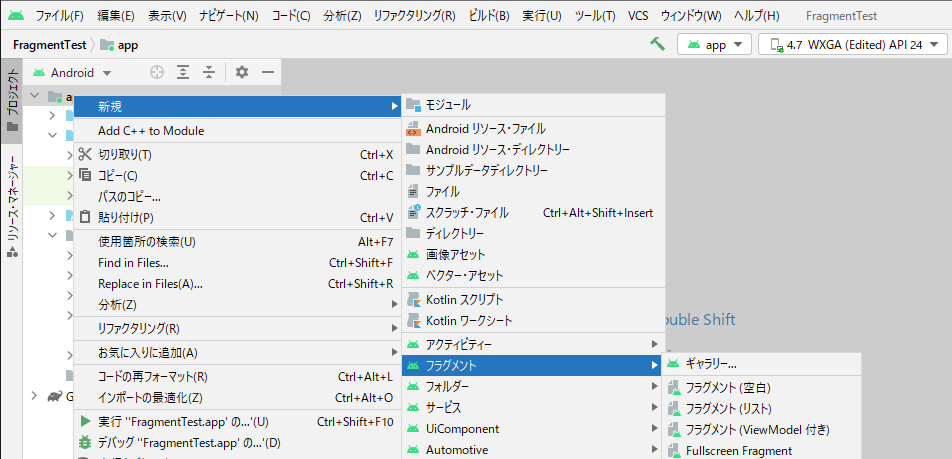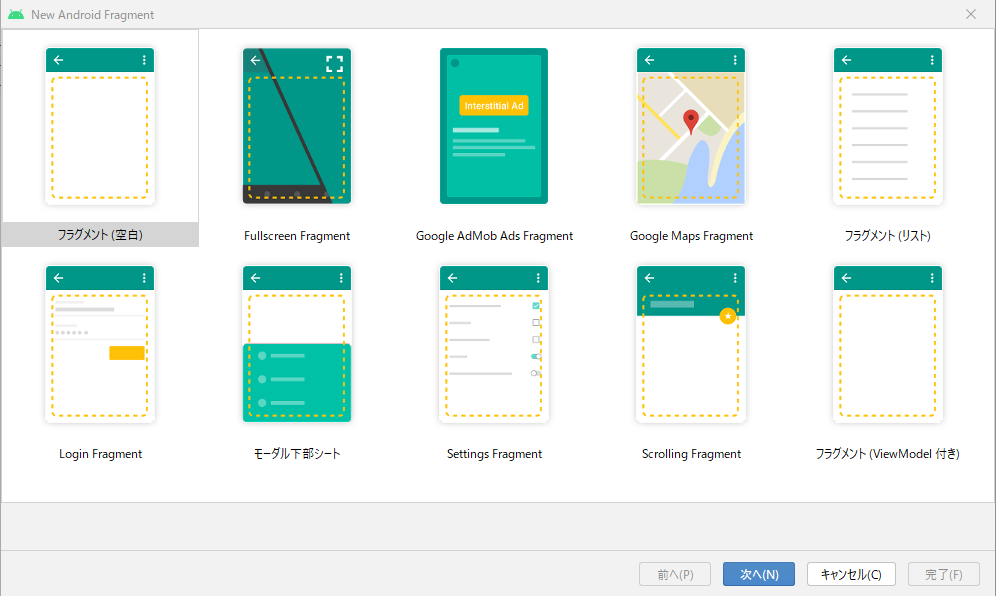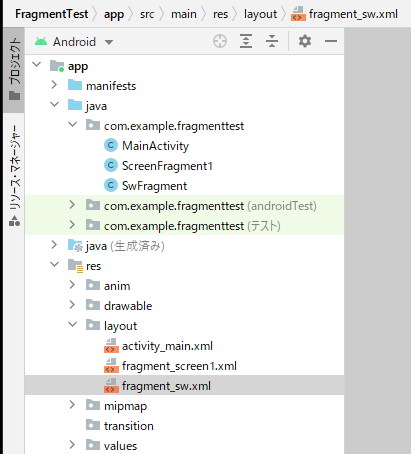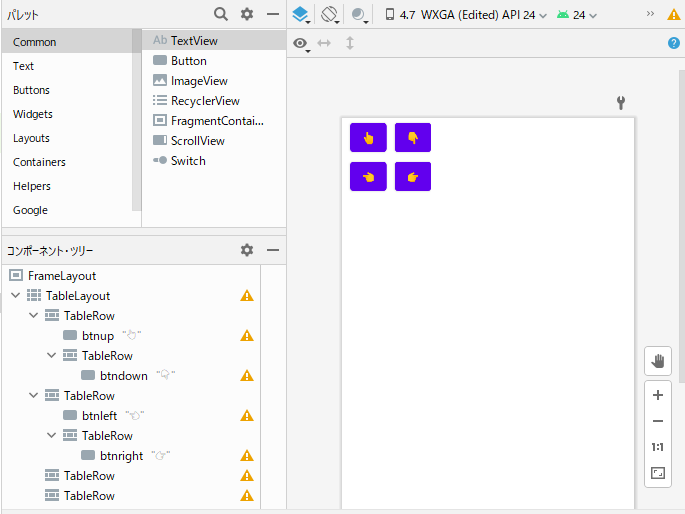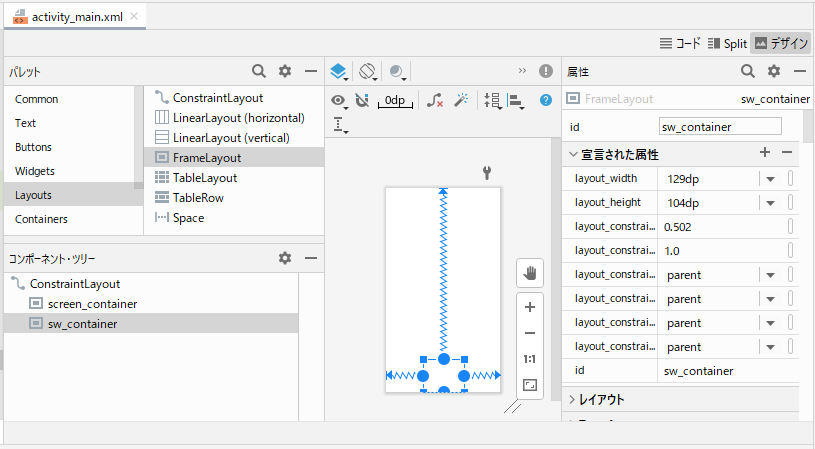Android端末で動作するFragmentを使った画面遷移アプリを作成します。画面遷移はFragmentを使って表示された遷移ボタンを使用します。画面遷移時には、Fragmentを使って表示された画面が上下/左右にアニメーションにより遷移します。
ここでは遷移ボタンを作成します。
- Android Studio Bumblebee|2021.1.1
- 開発言語:Java
関連するブログを次に示します。
最終的に作成した画面遷移アプリを次に示します。なおプロジェクト名は「FragmentTest」とします。
Fragmentの新規作成
Android Studioを使って次の手順でFragmentを作成します。
- 「ファイル」>「新規」>「フラグメント」>「ギャラリ」を選択します。
- 「フラグメント(空白)」を選択します。
- フラグメント名「SwFragment」、フラグメント・レイアウト名「fragment_sw」を設定します。
Fragmentを作成した結果、プロジェクトには次のように表示されます。画面遷移するためのフラグメント「ScreenFragment1」も含みます。
遷移ボタンの作成
画面の遷移方向を指示する上下/左右の遷移ボタンを次のように作成します。
- コンポーネントツリーには「FrameLayout」がすでに設定されています。ここにボタンなどを配置すると、左上に重なって表示されます。このため、「TableLayout」を配置して次のように4個のボタンを配置します。
左上のボタンの属性を次に示します。「layout_width」を55dpにしてボタンの幅を少し小さくし、「insetLeft」を10pdにしてボタン間に隙間を設けます。
作成したlayoutコード「fragment_sw.xml」を次に示します。
fragment_sw.xml
<?xml version="1.0" encoding="utf-8"?>
<FrameLayout xmlns:android="http://schemas.android.com/apk/res/android"
xmlns:tools="http://schemas.android.com/tools"
android:layout_width="match_parent"
android:layout_height="match_parent"
tools:context=".SwFragment">
<TableLayout
android:layout_width="wrap_content"
android:layout_height="wrap_content">
<TableRow
android:layout_width="match_parent"
android:layout_height="match_parent">
<Button
android:id="@+id/btnup"
android:layout_width="55dp"
android:layout_height="match_parent"
android:insetLeft="10dp"
android:text="👆" />
<TableRow
android:layout_width="match_parent"
android:layout_height="match_parent">
<Button
android:id="@+id/btndown"
android:layout_width="55dp"
android:layout_height="wrap_content"
android:insetLeft="10dp"
android:text="👇" />
</TableRow>
</TableRow>
<TableRow
android:layout_width="match_parent"
android:layout_height="match_parent">
<Button
android:id="@+id/btnleft"
android:layout_width="55dp"
android:layout_height="wrap_content"
android:insetLeft="10dp"
android:text="👈" />
<TableRow
android:layout_width="match_parent"
android:layout_height="match_parent">
<Button
android:id="@+id/btnright"
android:layout_width="55dp"
android:layout_height="wrap_content"
android:insetLeft="10dp"
android:text="👉" />
</TableRow>
</TableRow>
<TableRow
android:layout_width="match_parent"
android:layout_height="match_parent" />
<TableRow
android:layout_width="match_parent"
android:layout_height="match_parent" />
</TableLayout>
</FrameLayout>
Fragmentでの遷移ボタンのイベント処理
作成したFragment「SwFragment.java」で遷移ボタンのイベントを次のように処理します。
- 1行目でボタンのリスナーのインタフェースを宣言します。
- 16-19行目で各ボタンをリスナーに登録します。
- ボタンがクリックされると、25行目の「onClick」に制御が移ります。
- ボタンのIDに従いそれぞれ処理を行います。mListener.onClickDirectionメソッドは親の「MainActivity」とのデータ受け渡しに使用します(後で説明します)。
SwFragment.java
public class SwFragment extends Fragment implements View.OnClickListener {
・・・
@Override
public View onCreateView(LayoutInflater inflater, ViewGroup container,
Bundle savedInstanceState) {
// Inflate the layout for this fragment
View view = (View) inflater.inflate(R.layout.fragment_sw, container, false);
// ボタンの取得
Button btnup = (Button) view.findViewById(R.id.btnup);
Button btndown = (Button) view.findViewById(R.id.btndown);
Button btnleft = (Button) view.findViewById(R.id.btnleft);
Button btnright = (Button) view.findViewById(R.id.btnright);
// リスナーの登録
btnup.setOnClickListener((View.OnClickListener) this);
btndown.setOnClickListener((View.OnClickListener) this);
btnleft.setOnClickListener((View.OnClickListener) this);
btnright.setOnClickListener((View.OnClickListener) this);
return view;
}
@Override
public void onClick(View v) {
int btnId = v.getId();
if (btnId == R.id.btnup) {
System.out.println("UP!");
mListener.onClickDirection(MainActivity.BTN_UP);
} else if (btnId == R.id.btndown) {
System.out.println("down!");
mListener.onClickDirection(MainActivity.BTN_DOWN);
} else if (btnId == R.id.btnleft) {
System.out.println("left!");
mListener.onClickDirection(MainActivity.BTN_LEFT);
} else {
System.out.println("right!");
mListener.onClickDirection(MainActivity.BTN_RIGHT);
}
}
・・・
遷移ボタンの表示
次の手順に従って、Fragment上に作成した遷移ボタンをAndroid端末に表示します。
- 「activity_main.xml」を開き、パレットの「Layouts」から「FrameLayout」を選択して、コンポーネントツリーに次のようにドラッグします。この「FrameLayout」にFragment「fragment_sw.xml」上に作成した遷移ボタンの表示領域を指定します。
- 次の処理を追加して、Fragment「SwFragment.java」で作成した遷移ボタンを表示します。
FragmentTest/MainActivity.java
@Override
protected void onCreate(Bundle savedInstanceState) {
・・・
SwFragment swfragment = new SwFragment();
FragmentTransaction swtransaction = getSupportFragmentManager().beginTransaction();
swtransaction.add(R.id.sw_container, swfragment);
swtransaction.commit();
}
画面遷移アプリを実行して遷移ボタンをクリックすると、対応するボタン名が次のようにLogcatウインドウに表示されます。

